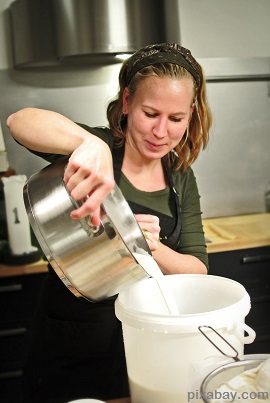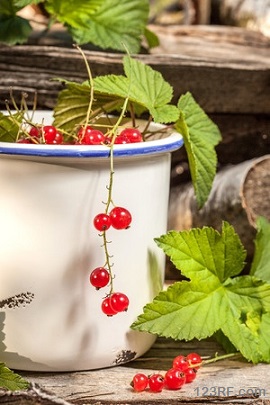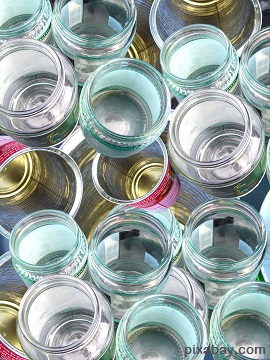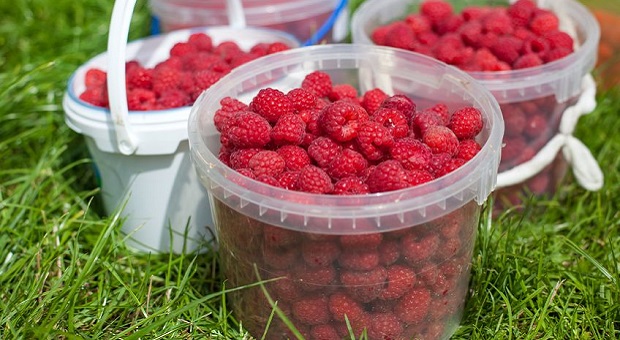It seems that everything comes in a plastic container that typically ends up in a landfill. Butter bowls, milk jugs, take-out containers, juice bottles; the list goes on.
Most municipalities have less-than-effective recycling programs, so is there a way to repurpose these containers? There certainly is. In fact, there are several ways. The secret, though, is to know how to clean them properly if you’re going to use them for food storage.
Stockpiling containers is a good idea in case SHTF because there are many different reasons that you’ll need them, especially if the disaster is long-term. How you should clean each container for safe re-use depends largely upon what the container is made of and what you’re going to use it for. Today, we’re going to discuss how to safely clean containers for stockpiling.
First, don’t buy any sort of plastic that has BPA in it. BPA, or bisphenol A, is an industrial chemical used in the production of plastics. This chemical has been known to leech out of the plastic and into the food or drink inside the container, especially when the container gets warm.
Even leaving your water bottle in the car can cause the plastic to heat enough to release the chemical, as can microwaving. Diseases such as cancer have been linked to BPA and it’s banned in many countries already.
Companies that produce plastic containers for the US have already started to address this issue because public awareness about the dangers of BPA has driven buyers to look for BPA-free plastics even if they have to pay more.
You can tell if a container has BPA in it by looking at the recycle symbol on it. If it has a seven inside the triangle, it likely contains BPA. Don’t buy it and if you do, don’t re-use it.
Lightweight Plastics
When I say “lightweight”, I mean plastic containers such as milk jugs, butter bowls and to-go containers. These plastics can’t really withstand much heat and bleach or other harsh chemicals can damage the plastic.
The best way to clean these items is to wash them in hot, soapy water. If you’re going to use the milk jugs to store water, drop a half capful of bleach into the jug after you’ve cleaned it with hot soapy water and refilled it halfway with warm water. Shake the jug thoroughly, then dump the bleach water out, turn the jug upside down and let it air-dry.
Heavy Plastics

Be sure that if you’re using a bucket (i.e., a 5-gallon bucket) that it’s made of food-grade plastic and hasn’t contained anything other than food or water. It’s not a fabulous idea to store your bulk flour in a bucket that had motor oil in it, no matter how much you clean it!
Five-gallon buckets can be your best friend when it comes to food storage. You can get them for free from local restaurants because bulk food such as pickles, icing and sauces come in them.
Be warned though that if it’s a pickle bucket you may want to deodorize it before you store flour or other food in it so that it doesn’t pass the flavor on to other foods. You can do this by leaving the bleach water solution in it for an hour or so then let it air-dry.
If you want to store the containers for use later and don’t want them to smell musty, toss in a couple of charcoal briquettes after letting it dry completely. Then put the lid on and it’ll smell nice and fresh when you get around to using it.
Ceramic or Stoneware Containers

To clean a ceramic or stoneware container, just use hot soapy water followed by a soak in the same bleach solution described above.
A couple of notes about using ceramic or stoneware: first, make sure that the container I glazed on the inside with food-safe glaze. Some glazes are made with minerals that will leech into food and aren’t suitable for food storage.
Also, ensure that there are no cracks or chips in the container before you use it because the surface is glazed to seal the container from germs and bacteria. If the glaze is chipped or cracked, bacteria will seep into the extremely porous ceramic or stoneware and can make you extremely ill.
Glass Containers

Cracks can also cause air to slowly leak into the jar which lets bacteria into the food that’s stored inside. Chips along the rim will keep the jar from sealing properly and will also cause your food to spoil.
When it comes to re-using glass containers, don’t use them for canning, but if they have a seal, they may be great for storing items such as seeds, herbs, flour, rice or other goods that don’t require a seal but do need to be stored in an airtight container.
To clean glass containers, hot soapy water is the best bet. You can also follow with bleach water as described above if you really want to be sure that all germs and bacteria are dead. If you need to sterilize them for canning, place them in your canner and fill them with warm water to within an inch of the top. Fill the canner with water to that depth, too. Bring to a boil and boil for 10 minutes, adjusting for altitude as necessary.
There are certain benefits to stockpiling each type of container here. Plastics stack easily, don’t take up much space (if they stack), and are lightweight. However, they can’t tolerate heat. Milk jugs are great to store water in. Ceramic is great to stockpile if you’re going to be fermenting foods. Glass is universal; you can use it for just about anything, it tolerates heat and can be used over and over.
Regardless of what type of container you choose to stockpile, you need to make sure that they’re food-safe and free of damage. Follow cleaning directions in order to keep from getting sick. If you have any other suggestions for stockpiling containers, please let us know about them in the comments section below.
“The one thing that can impact the presence of disease the most is a lack of hygiene” CLICK HERE to find out more!
This article has been written by Theresa Crouse for Survivopedia.








Pingback:How To Safely Clean Containers For Stockpiling - Survivalot | October 30, 2015
|
Pingback:How To Safely Clean Containers For Stockpiling | Freedom Newz | October 30, 2015
|
Pingback:How To Safely Clean Containers For Stockpiling | Prepper's Survival Homestead | October 30, 2015
|
Pingback:How To Safely Clean Containers For Stockpiling - Survival By Preparedness | October 30, 2015
|
Robert Trail | October 30, 2015
|
Ammonia was used on milk equipment for cleaning at the dairy I grew up near.
Rattlerjake | October 30, 2015
|
Be extremely careful reusing plastic. Check to see what type of plastic is used and to ensure they are BPA free, otherwise BPA will leach into whatever is stored in the container.
Laura | October 30, 2015
|
On 5 gallon buckets, I make sure they are food grade, but I still either leave the food (rice, beans, cat food, etc.) in the original container, or use a mylar food storage bag designed for long term storage. That way any residual smell from recycled containers does not change the taste (like using containers that had syrup in them, of which I have several).
The other comment on reusing glass containers, mason jars are designed to be used, and reused over and over again. Just make sure they are cleaned good, disinfected, either boiling water or the proper cycle on the dishwasher, also, no chips or cracks. They will last generations.
Methane | October 30, 2015
|
I thought milk jugs were not safe to store drinking water in. Impossible to get all remnants of milk scrubbed out of them. Might use them for laundry, bathing, flushing toilets maybe.
Theresa | November 2, 2015
|
Hey Methane! If you wash the milk jug as soon as you empty it with hot, soapy water, then all of the milk will come out. As a matter of fact, I use a milk jug to make my iced tea in. The trick is to fill it about 1/3 of the way with very warm water, add a couple of drops of dish soap, put the lid back on and shake it like crazy. It’ll take a few rinses to get all the soap out but it’s nice and clean and free of milk when you’re done. Just rinse it the same way that you washed iit – by putting water in it and shaking it – until there are no more soap bubbles when you shake it.
Ellen | November 1, 2015
|
Many years ago when I started prepping I stored water in the milk jugs.
Several months later when I checked on them several had started leaking.
Soda bottles have not leaked. Do not store on cement! It will change the taste of the water.
Can the plastic tanks from a farm supply store be used to store drinking water?
Theresa | November 2, 2015
|
Hi Ellen! If you’re talking about the big plastic containers used to store livestock water, then yes, the are safe to stockpile water it. I would advise against leaving them outside unless you’re going to be using the water regularly, such as to catch rainwater and water your plants with because sunlight can promote algae growth.
Pingback:How To Safely Clean Containers For Stockpiling | TheSurvivalPlaceBlog | November 2, 2015
|
Pingback:12 Survival & Homesteading Uses For Coffee - Survival By Preparedness | November 3, 2015
|
Pingback:Survival News 10/30/15 - Survival By Preparedness | November 3, 2015
|
Wm h marrs | November 4, 2015
|
Never, Never, Ever Use a Plastic Milk Jug for ANYTHING ! This Material is LDPE (low density polyethylene) and is porous to begin with. And, Never, Never, Ever Microwave ANY Plastic Container – the High Freq. RF will alter the material structurally, and will most Certainly Release BPA to the surface. Microwaving Glazed Ceramics and Glass will likely affect the surface Micro-Structure. You have been warned.
mike | November 6, 2015
|
We have several plastic drinking cups that say BPA free right on the cup and the recycle symbol has a 7 inside. Are you sure plastic with the 7 has bpa? If so our cups have been falsely advertised.
Rattlerjake | November 8, 2015
|
If you have any questions about plastics and which are safe: http://www.nationofchange.org/numbers-plastic-bottles-what-do-plastic-recycling-symbols-mean-1360168347
Remember, there are many consumer products that manufacturers say is safe, yet later are found to be lies, “Buyer Beware”! Glass, stainless steal, and aluminum are the preferred materials for use and storage.
Pingback:The Best Way To Stockpile Vegetables Off-Grid - Survival By Preparedness | November 11, 2015
|
Pingback:The Best Way To Stockpile Vegetables Off-Grid | Freedom Newz | November 11, 2015
|
Pingback:Top 10 Chemicals Food Labels Won’t Tell You About | Freedom Newz | November 30, 2015
|
Pingback:9 Ways To Reduce Food Waste This Christmas | Survivopedia | December 24, 2015
|
Pingback:9 Ways To Reduce Food Waste This Christmas | Prepper's Survival Homestead | December 24, 2015
|
Pingback:9 Ways To Reduce Food Waste This Christmas | | disasterdefense.us | December 25, 2015
|
Pingback:Essential Info On Properly Preparing Containers For Survival | Survival Frog Blog | February 1, 2016
|
Pingback:How To Store Tap Water For Survival | Survivopedia | March 12, 2017
|
Pingback:How To Make A 5 Gallon Bucket Survival Kit | Survivopedia | March 31, 2017
|